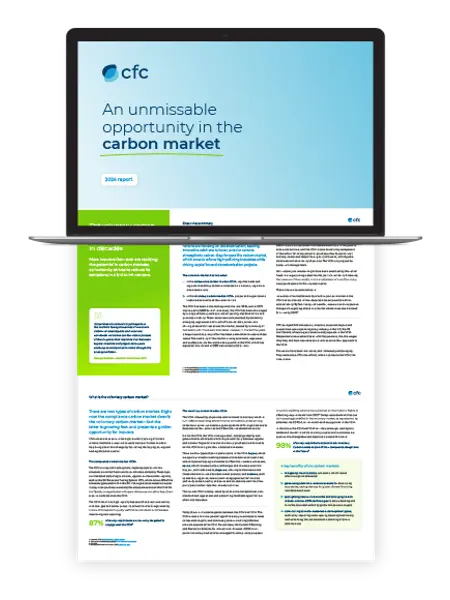After intensive research and consultation, CFC are delivering a product that provides the peace of mind that the voluntary carbon market is looking for
Find out more about our carbon product suite
Carbon delivery insurance
For companies purchasing nature-based carbon credits on a forward basis, to use them against their unavoidable emissions. The product wraps the forward purchase of carbon credits to mitigate non-delivery from any cause.
Key features
- Contract certainty for forward purchases
- Financial protection against delivery shortfalls
- Additional quality assurance with an insurance backstop
- Underwriting the carbon project, not the policyholder
Carbon cancellation insurance
For companies who own or have retired carbon credits. The product safeguards purchased carbon credits from financial and management risks in the event of cancellation or invalidation.
Key features
- Contract certainty for issued credits
- Financial protection against credit invalidation or reversal
- Additional quality assurance with an insurance backstop
- Adverse media and crisis management support arising from a project invalidation event
Carbon lenders non-payment
For entities, typically banks or investors, looking to provide debt investment to developers. Our lenders non-payment insurance wraps loans to carbon project developers to be repaid by the sale of carbon credits. The policy covers non-repayment on an all-risks basis, including project performance failure for any reason.
Key features
- De-risks 100% lenders money to unlock debt opportunity for carbon related opportunity
- Compliance with Basel regulations allows capital relief for certain lenders
- Financial certainty for loans backed by a stream of carbon credits to be generated in the future
- Financial protection against delivery shortfalls
- Additional quality assurance with an insurance backstop
The carbon market is designed to revamp heavily polluting sectors while channeling investments into decarbonization endeavors
Globally, individuals, businesses, and entire nations are directing their efforts towards decarbonization, exploring inventive methods to reduce, prevent, or eliminate atmospheric carbon emissions.
The carbon market
There are two parts of carbon market, the compliance carbon market (CCM) and the voluntary carbon market (VCM).
The CCM is a ‘cap and trade’ system, meaning there are caps on the amount of emissions permitted from a sector or company. The CCM is subject to robust regulation.
The voluntary carbon market (VCM) is fuelled by the growing demand for organizations to decarbonize their activities and offset their emissions. The VCM is unregulated and guided by non-governmental standards which vary dramatically between countries.

Carbon credits
Carbon credits (or carbon offsets) are produced by any activity that lowers or removes emissions. These activities generally come in the form of carbon projects such as biochar, blue carbon, carbon capture, direct air capture or forestry.
1 carbon credit = 1 tonne of carbon dioxide equivalent which has been reduced, avoided, or removed from the atmosphere.

Carbon projects
The key types of voluntary carbon credit projects
Biochar - A residual charcoal from biomass heating is used to store carbon in the land
Blue carbon - Any carbon project in an ocean or coastal environment
Carbon capture storage - CO2 emissions are captured from industrial processes
Direct air capture - Atmospheric carbon is filtered and pumped into underground stores
Forestry - Forests are grown, restored or maintained

Benefits
1. Help reduce more-difficult emissions, which would otherwise go unaddressed
2. Generate additional revenue streams for developing economies
3. Discover new technologies that aid in carbon dioxide removal and help drive the demand
4. Contribute to wider sustainable goals (eg improving water quality, boosting biodiversity)

Carbon insurance: An unmissable opportunity
More insurers than ever are realizing the potential value of carbon markets. By facilitating risk transfer, insurers can effect positive change in a carbon market whose value could exceed $1 trillion by 2050.

The role of insurance in the carbon market
Hear from George Beattie, Head of Innovation at CFC and Ian Meadows, Carbon Market Expert.
FAQs
What is carbon insurance?
Carbon insurance protects the purchase of carbon credits. Carbon credits are purchased from carbon projects which can be directly affected by a multitude of external factors. These risks can contribute to the reversal, invalidation or non-delivery of carbon credits, which leaves the carbon credit buyer exposed.
The consequences go on to include reputational harm if a buyer is associated with a project deemed inefficient, unethical or fraudulent; and those in certain industries where offsetting is a regulated activity (e.g. airlines buying CORSIA eligible credits) may face compliance repercussions.
Carbon insurance protects against all of these exposures.
Find out more about our carbon product
What's the difference between the compliance and voluntary carbon market?
There carbon market has two sides:
1. In the compliance carbon market (CCM), regimes trade and regulate mandatory carbon allowances on a national, regional or international level
2. In the voluntary carbon market (VCM), people and organizations trade carbon credits of their own volition
The CCM has been in the making since the late 1990s, and in 2023 was valued at $800 billion. In contrast, the VCM has been challenged by a range of factors, such as a lack of liquidity, standardization and price explainability. These issues were compounded by constantly emerging regulations and a lack of historical data, as well as a chilling sense of distrust across the market, caused by a minority of bad actors with fraudulent intentions. However, in the last five years a huge cross-disciplinary effort has been undertaken to resolve these issues. The credibility of the market is rising as science, regulation and professionalism fuel sustainable growth in the VCM, which has exploded into life and in 2022 was valued at $2 billion.
How big is the voluntary carbon market?
In 2022, the voluntary carbon market was valued at $2 billion. However its valuation is predicted to skyrocket, the earliest estimate of it hitting $1 trillion coming as early as 2037.
Insurers are guaranteed to play a vital role in accelerating this process, empowering market participants to overcome the risks inherent in their decarbonization activities.
What are the problems with the voluntary carbon market?
The voluntary carbon market (VCM) is fueled by corporates’ commitment to net zero, which in turn reflects expanding environmental conscientiousness among consumers, as well as investors’ growing demand for organizations to decarbonize their activities and offset their unabated emissions.
Unlike the compliance carbon market (CCM), the VCM is unregulated, instead guided by nongovernmental standards which vary dramatically between regions and nations. Organizations can voluntarily purchase carbon credits on the VCM to mitigate their unabated emissions.
The risks associated with the VCM are low-frequency but high severity, and can materialize at any stage of a carbon project’s lifecycle. At present these risks are mostly transferred from one market participant to another. For example, an actor might manage delivery risk using contractual agreements, and mitigate reversal risk via buffers. These more traditional means make sense, but they often lack efficiency, place risk on a party ill-suited to bear it and even raise barriers to entry in this emerging market.
Carbon projects can also be directly affected by a multitude of external factors such as natural catastrophes (such as fires, floods or hurricanes), fraud, crime and corruption, seller bankruptcy and government intervention (such as export bans), and legal and regulatory changes.
Find out more in our report
Who buys carbon credits and why?
Investors seeking exposure to carbon as an asset class, and companies buying allowances to offset their residual emissions.
Find out more in our report
How much is one carbon credit worth?
Carbon credits (or carbon offsets) are produced by any activity that lowers or removes emissions. This can be through nature-based solutions, like reforestation and the protection of natural high-carbon-stock assets like peatland, or technological innovation, including carbon capture storage (CCS) and direct air capture (DAC).
1 carbon credit = 1 tonne of CO2e (carbon dioxide equivalent) which has been reduced, avoided, or removed from the atmosphere
Carbon credits allow a company to emit a certain amount of CO2 or other greenhouse gases. It gets a set number of carbon credits, which decline over time, but any excess credits can be sold to another company.
Through the carbon credit system, emission reductions can be measured and verified, which contributes to a meaningful lowering in the amount of CO2 and greenhouse gases in the atmosphere.
Carbon credits are an effective mechanism for incentivizing organizations to reduce their emissions. Those unable to do so are still able to operate, but inevitably at a higher cost.
Find out more in our report







